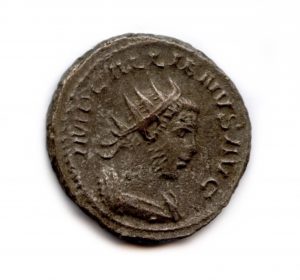[R1979.11.0206]


[R1979.11.0210]


Description
Obverse:
IMP GALLIENVS AVG
(Imperator Gallienus Augustus)
Bust of Gallienus facing right. He wears a radiate crown on his head, and a cloak around his shoulders. The two coins have the same text and images on them however one of the coins is visibly very worn and difficult to decipher whereas the other is in much better shape and much easier to read. On the obverse of one coin Gallienus’ beard is clearly visible in the imagery depicting him, however on the other coin his face is very worn and it is difficult to see much detail.
Reverse:
VICTORIA GERMAN
(Victoria Germanica)
To the left is a Victory, facing right and holding a wreath towards Gallienus, who is shown to the right. Gallienus is facing left and holds a spear upright in his left hand and what appears to be a globe in his left. There is a star above the wreath on .210 but not .206. Gallienus and the Victory are both made smaller on .210 to make room for the star.
Other notes: Both coins appear considerably worn, as the text is not clear, and some parts of the images have faded. The reverse of .210 is noticeably discolored in some areas, as green and orange spots can be seen in at the bottom of the coin and the top right. The antoniniani had 42% silver at the beginning of Gordian’s reign, but by the end of Valerian’s reign, the silver content of these coins was reduced to 15% (Bland 2012). The green discoloration of .210 shows that it was debased with bronze.
Commentary
The obverse legend translates to Emperor Gallienus Augustus (Swoveland 2003). Augustus is the title meaning “revered” that had been bestowed upon Rome’s first emperor by the senate in 27 BCE. Augustus became the title for all successive emperors and during the late empire senior emperors were called “Augustus” and junior emperors were called “Caesar.” Gallienus ruled jointly with his father Valerian from 253-260 CE, and then solely from 260 until his death in 268. The images displayed on the coin appear to portray the message that Gallienus was a powerful leader who was successful in battle. Gallienus won battles against enemies such as the Iuthungi and Alamanni (Franke 2006). These victories are portrayed through both the image and legend of Victory on the reverse. Inscribed on the reverse of the coin is VICTORIA GERMAN which is referring to and celebrating Gallienus’s victory over the Germanic tribes, though it is important to note that Gallienus claimed to have won even more than he did (Manders 2012, 277-278). The image of a tall spear in Gallienus’s grasp further portrays him as a strong military leader, and the globe in Gallienus’s hand seems to suggest that the world belonged to the emperor. Such an image was necessary, considering that Gallienus lived during a period in which forces such as the Persians, Germanic tribes, and uprisings were a constant concern (Manders 2012, 297). The Persians captured Gallienus’ father, the co-emperor Valerian in 260, showing how threatening these powers were (Encyclopaedia Britannica).
The obverse shows a portrait of the emperor, with a radiate crown on his head. The spikes on this crown were meant to represent the rays of the sun (Gilbert 2020). Gallienus and other third-century rulers were frequently depicted on coins wearing this type of crown (see for example RIC V Gallienus joint 8). His beard is also made clear, as was customary for portraits of Gallienus though not for his father Valerian (see again RIC V Gallienus joint 8 and compare the coins of Valerian here).
While these coins show Gallienus standing with Victory, on others he appears in a similar arrangement with his father, Valerian. The composition and message of the reverse imagery are very similar to two nearly identical coin types issued by both Valerian and Gallienus during their joint rule, RIC V Valerian 292 and RIC V Gallienus (joint) 456, where the two figures are Gallienus and Valerian, one holding a globe and the other holding a small figure of Victory, with the legend VIRTUS AVGG, “courage of the emperors.” The Victory, spear, and globe combination on all these coins shows that victory in battle was a key theme that Gallienus and his father wanted to display to the Romans.
This coin type has been dated to 256-257. The earliest Gallienus coin with a transcription similar to VICT GERMAN listed in the OCRE is RIC V Gallienus (joint reign) 173, dated to 254-255, while the latest is RIC V Gallienus (joint reign) 430, dated 258-259. Unlike the coins presented here, however, these coins do not show the emperor Gallienus on the reverse. Instead, Victory stands alone, with a captive at her feet.
Works cited:
Bland, Roger. 2012. “From Gordian III to the Gallic Empire (AD 238–274).” In The Oxford Handbook of Greek and Roman Coinage, e.dited by William E. Metcalf. Oxford: Oxford University Press. Accessed December 6, 2020. DOI: 10.1093/oxfordhb/9780195305746.013.0029
Franke, Thomas. 2006. “Gallienus,” In Brill’s New Pauly, edited by Hubert Cancik, Helmuth Schneider, and Christine Salazar. Leiden: Brill. Accessed December 1, 2020. DOI: http://dx.doi.org/10.1163/1574-9347_bnp_e418440.
Gilbert, Kate. 2020. “Guide to Obverse Types.” Ancient Coins for Education. Accessed December 6, http://ancientcoinsforeducation.org/content/view/60/81/
Manders, Erika. 2012. Coining Images of Power. Patterns in the Representation of Roman Emperors on Imperial Coinage, A.D. 193-284. Leiden: Brill. doi: https://doi.org/10.1163/9789004224001
OCRE. Online Coins of the Roman Empire, American Numismatic Society. Accessed December 6, 2020.http://numismatics.org
Swoveland, Michael S. 2003. “Reading Ancient Roman Coins.” WNC Coins. Accessed December 1, 2020. http://www.wnccoins.com/0022.htm.
“Gallienus.” Encyclopædia Britannica. Encyclopædia Britannica, inc. Accessed December 1, 2020. https://www.britannica.com/biography/Gallienus.
Coin type: RIC V Gallienus (joint reign) 452; Sear 10393 (assigned to “eastern field-mint, AD 257-8”)
Research by: Cade Agatone, Class of 2023; Ryan Nevin, Class of 2024; Nate McShane, Class of 2024